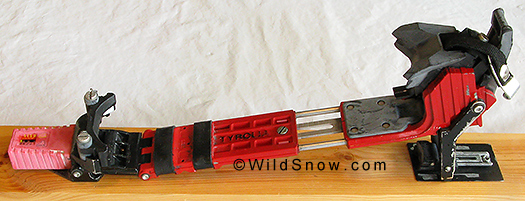In the history of randonnee bindings, you get the feeling certain companies used complexity as a design and marketing goal. I mean, some of the things look like they must have taken a raft of engineers and 600 gallons of espresso just to go from sketch to prototype, let alone manufacturing. The peak of such folly might have been 1982, when Marker released their M-Tour battleship and Tyrolia introduced their TRB navy destroyer. I added the TRB to our online binding museum yesterday. What you’re reading here is an intro and place for comments, Check out the full display here.

Tyrolia TRB backcountry skiing binding of 1982 is complex and heavy, but had some interesting features and was somewhat popular.
Both the Tyrolia TRB and Marker M, while amazingly full featured, rivaled the complexity of a laser printer and had the mass of a sandbag. Thus, not surprisingly it was that same year that Fritz Barthel began developing the snowflake light tech (Dynafit) binding in earnest, which not long after that sent the AT binding world into a tizzy by making gigantic frame bindings such as TRB and M look like Edsels. (To be fair, the somewhat problematic yet usable Ramer bindings of that period were significantly light in weight.)
The elegance of tech bindings aside, while we probably couldn’t even lift our legs with a binding such as a TRB on our feet, they’re fun to observe and quite interesting in how they solved problems such as ski flex and the near biblical necessity of latching the heels for the down while still being able to effectuate a walking stride on the up. Probably the most interesting part of the TRB is a double pivot in the binding plate/frame, which acted a bit like the now extinct but fascinating Naxo binding of just a few years ago. Another feature of the TRB is a toe that on first glance appears to be alpine-like and was thus good for marketing, as tour skiers coming from an alpine background have always been skeptical of bindings that do their side release by rotating out at the heel (as the Marker M does, as well as all tech bindings.)
More in the Tyrolia TRB backcountry skiing binding museum display. Enjoy this bit of our history.
WildSnow.com publisher emeritus and founder Lou (Louis Dawson) has a 50+ years career in climbing, backcountry skiing and ski mountaineering. He was the first person in history to ski down all 54 Colorado 14,000-foot peaks, has authored numerous books about about backcountry skiing, and has skied from the summit of Denali in Alaska, North America’s highest mountain.
